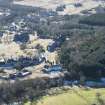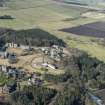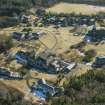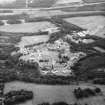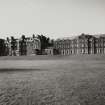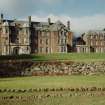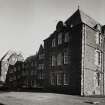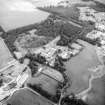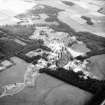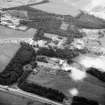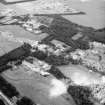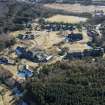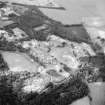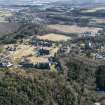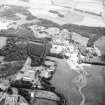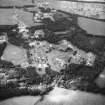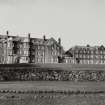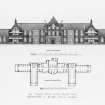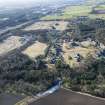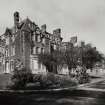Dechmont, Bangour Village Hospital, Nurses Home
Nurses Home (20th Century), Psychiatric Hospital (20th Century)
Site Name Dechmont, Bangour Village Hospital, Nurses Home
Classification Nurses Home (20th Century), Psychiatric Hospital (20th Century)
Canmore ID 248421
Site Number NT07SW 18.02
NGR NT 03104 71113
Datum OSGB36 - NGR
Permalink http://canmore.org.uk/site/248421
- Council West Lothian
- Parish Ecclesmachan
- Former Region Lothian
- Former District West Lothian
- Former County West Lothian
Nurses' Home porches flanked by two octagonal towers capped with lead ogee roofs, extended by E J Macrae, 1931. The E-plan Medical Hospital has a projecting three-storey turreted entrance. Administrative Centre in plain bright harl and red sandstone dressings is vaguely Scots Revival. Awaiting conversion to housing with pockets of infill.
Taken from "West Lothian: An Illustrated Architectural Guide", by Stuart Eydmann, Richard Jaques and Charles McKean, 2008. Published by the Rutland Press http://www.rias.org.uk
3-storey and attic, 11-bay, symmetrical, restrained Scots Renaissance style former nurses home with single-storey linking corridor to later 1931, 3-storey, 14-bay symmetrical extension to E. Situated on prominent site to rear of former Bangour Village Hospital complex. Roughly coursed and snecked red sandstone with contrasting cream ashlar margins and quoins. Base course, cornice. Round-arched dormerheads breaking eaves. Small square, flat-roofed dormers. Some later stairwell additions to rear (N) and E.
Bangour Village Hospital is the best surviving example in Scotland of a psychiatric hospital created in the village system of patient care, a revolutionary concept in the late 19th century. The former nurses home of Bangour Village Hospital is an integral and important part of the former psychiatric hospital complex and is situated in a prominent and high position towards the rear of the site. Built in a restrained Scots Renaissance style, the home has very good external detailing, including the distinctive ogee-roofed twin towers to the front elevation. The later extension continues the original Scots Renaissance form in a less decorative manner.
The buildings of the Bangour Village Hospital sit within their original rural setting and remain largely externally unaltered. The former nurses home originally had 88 single rooms for the nurses who worked in the medical building (see separate listing). There were general public rooms and the building was looked after by a housekeeper and 6 staff. The extension was added as the hospital expanded.
The village system of patient care, exemplified by the Alt-Scherbitz hospital, near Leipzig in Germany in the 1870s encouraged psychiatric patients to be cared for within their own community setting, where there were few physical restrictions and where village self-sufficiency was encouraged. This was in contrast to the large contemporary asylum buildings. This philosophy had been gradually developing in a number of Scottish institutions, but Bangour saw its apotheosis, specifically in relation to psychiatric patients. Two other hospitals were built in Scotland for psychiatric patients, Kingseat, to the north of Aberdeen (built in 1904) and Dykebar Hospital in Paisley, 1909 (see separate listing). These have not survived as completely as Bangour.
The hospital was built by the well-known Edinburgh architect Hippolyte J Blanc as a result of a competition begun in 1898. The Edinburgh Lunacy Board had concluded that a new psychiatric hospital was required to cater for the increasing numbers of patients from Edinburgh and the hospital was opened in 1906, with some of the buildings still to be completed. It was designed with no external walls or gates. The utility buildings were positioned at the centre of the site, the medical buildings for patients requiring medical supervision and treatment were to the E and there were villas to the W of the site which could accommodate patients who required less supervision and were able to work at some sort of industry. The complex also included a farm to the NW (not part of the current site) and had its own water and electricity systems and also had its own railway. The hospital was commissioned by the War Office in WWI for wounded soldiers and extra temporary structures were erected, Most of which were dismantled after the War although some timber ones were retained by the hospital. The railway too was dismantled in 1921. The patients returned in 1922. The hospital was commissioned again for WWII. At this time many temporary shelters were erected to the NW of the site and this became the basis of the Bangour General Hospital (now demolished). Bangour Village Hospital continued as a psychiatric hospital until 2004.
Hippolyte J Blanc (1844-1917) was an eminent and prolific Edinburgh-based architect who was perhaps best known for his Gothic revival churches. He was also a keen antiquarian and many of his buildings evoke an earlier Scottish style.
Ebenezer MacRae (1881-1951) was the Edinburgh City Architect from 1925 until his retirement in 1946. He was a pioneer of conservation and restored a number of buildings in the Edinburgh Old Town.
List description revised, 2012. The Nurses Home was formerly listed at category A as part of a single listing covering Bangour Village Hospital. Category changed to B following listing review, 2012. (Historic Scotland)




























